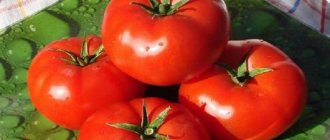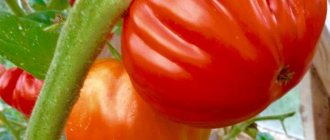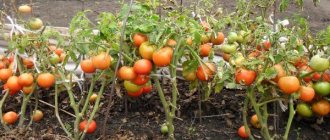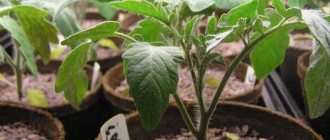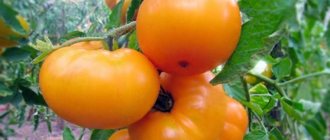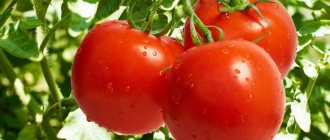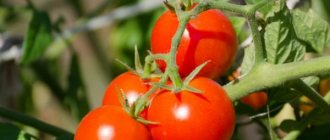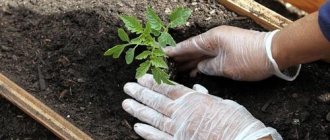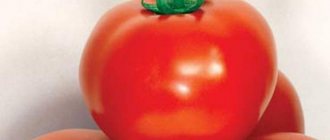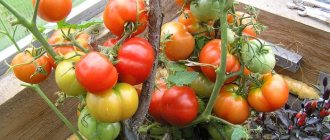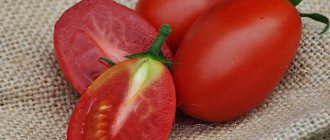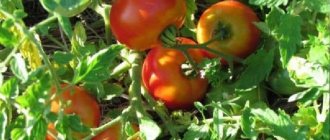Persimmon is not only a wonderful, healthy fruit, but also a very tasty tomato variety. Its fruits, indeed, externally resemble the well-known product of the same name: their surface is glossy, bright orange, and round in shape. The pulp of Persimmon tomatoes is tender, juicy and sweet. “Persimmon” is grown by many farmers in different regions of the country in open areas of land and under cover. A full description of the variety and the main characteristics of the “Persimmon” tomato can be found further in the article. Perhaps, after getting acquainted with this wonderful variety, there will be even more admirers of its taste.
Description and characteristics of the variety
The tomato reaches a height of 0.7-1.5 m. It is a medium-sized, easy-to-care variety. The leaves are dark green and medium in size.
The variety appeared in an ordinary garden bed. The yellow Persimmon tomato was bred through domestic selection efforts and entered into the State Register in 2009.
What features are inherent in bushes:
- the first brush appears after 7-9 leaves;
- 4-6 tomatoes are tied in clusters;
- foliage and branching are moderately expressed.
Depending on the conditions of the tomato, the height of the bush may vary:
- in greenhouse conditions, the length of the trunks reaches 1.4-1.5 m;
- in open beds the height is within 70-80 cm.
Hybrid or variety? The variety is non-hybrid, but it has no fewer positive properties than hybrids, including strong immunity and proven resistance.
The medium-sized Persimmon tomato is a determinate standard variety. Requires gartering and pinching. Fixation is carried out to strong supports and to trellises in high greenhouses.
What are the characteristics of the Khurma tomato from Siberian Garden:
- average weight 300-400 g;
- round shape, like a real fruit of the same name;
- fleshy, sugary pulp;
- seed chambers 4-6;
- sugars 5-6%;
- The taste is dominated by sweet notes with fruity undertones.
The Persimmon tomato from Gavrish bears bright orange fruits with excellent taste. It has tender fleshy flesh. Fruiting lasts from July to September-October. In total, it lasts up to 5 months.
The yellow Persimmon tomato begins to bear fruit early. Already after 85-110 days from germination, the first harvest is harvested.
Fruiting occurs in mid-July. But the timing is affected by weather conditions. In wet, damp weather, ripening occurs later.
Tomato Persimmon from "Aelita" bears fruits that are characterized by:
- average weight 230-250 g.
- the largest ones weigh 500-600 g.
- dry matter 4-6%.
- the shape is round and flattened.
For sales and commercial purposes, farmers choose the Khurma tomato from Russian Garden, which has good shelf life and transportability. The fruits are top sellers on the early tomato market. They are in demand due to their beautiful appearance and excellent taste.
Features of cultivation
The technology for cultivating the Persimmon tomato is traditional for determinate, medium-growing varieties.
Deadlines
Seedlings are planted in a permanent place at the age of 55–60 days. Based on the intended growing location, the timing of sowing seeds for seedlings is calculated. Preparing seedlings for greenhouses begins in late February - early March, for open ground - in April. Sowing dates are adjusted taking into account the region and weather conditions.
See also: The best varieties of tomatoes for growing in Ukraine
Sowing seeds
To grow seedlings, use ready-made purchased soil or garden soil, previously disinfected with a solution of potassium permanganate or foundationol. In extreme cases, the soil can be heated in the oven for half an hour. Shallow containers are used for sowing. The soil is moistened and compacted. Ready-made purchased seeds are sown to a depth of no more than 1 cm. Home-produced seeds are pre-soaked in a solution of potassium permanganate for disinfection.
To prevent the seedlings from stretching out, strictly monitor the temperature and lighting level.
Important! To preserve moisture until germination, keep the container covered with transparent glass or film, ventilating periodically.
At the stage of one or two true leaves, the seedlings are planted in separate pots measuring at least 8x8 cm.
Hardening off seedlings
The temperature regime when growing seedlings significantly affects its quality. For Persimmon tomato, maintain the temperature:
- before emergence +25 ºС;
- the first 7–8 days after germination +14…+16 ºС.
- in the future +20…+22 ºС.
At night, the air temperature is lowered.
Expert opinion
Stanislav Pavlovich
Gardener with 17 years of experience and our expert
Ask a Question
Two to three weeks before planting in the ground, seedlings begin to harden off. Plants are left on the balcony or veranda, where the air temperature is several degrees lower. Subsequently, the seedlings are taken outside, increasing the hardening time daily from 30 minutes to several hours. At the same time, make sure that the plants do not get burned from the bright sun and are not damaged by the cold northern wind.
Landing in the ground
Planting seedlings in the ground begins when the air temperature is no lower than +15 ºС and night frosts stop. Cabbage, legumes and forage crops are chosen as precursors. The ridges are prepared two weeks in advance, loosened, mineral fertilizers and humus are applied. The holes are dug according to the size of the root ball and moistened well. Persimmon tomato seedlings are planted at the rate of 3–4 plants per 1 m2 in ribbons or in a checkerboard pattern. The distance between plants is 45–50 cm, row spacing is 60–70 cm.
Expert opinion
Stanislav Pavlovich
Gardener with 17 years of experience and our expert
Ask a Question
Advice! Before planting, it is recommended to treat the seedlings with a growth stimulator and water them abundantly.
How to grow seedlings
Growing healthy and strong seedlings is extremely important, since the future health and productivity of the plant depends on it. Let's consider the features of cultivation at the initial stage
Seed preparation
To make the seeds germinate faster, soak them. Before planting, cover the seeds with warm water and leave for 1-2 hours. Seeds that float are unsuitable for planting. The rest can be safely used.
Soaking in growth stimulants (for example, “Baikal”, “Epin Extra”, “Zircon”) helps to increase resistance to various diseases.
Container and soil
Tomatoes prefer slightly acidic, closer to neutral soil of 5-6 pH.
For planting, use ready-made universal substrates or prepare the mixture yourself: mix sand, peat and soil in equal proportions. The disinfection mixture prepared independently is calcined in the oven and spilled with a solution of potassium permanganate.
In the process of growing seedlings, you will need two types of containers:
- a low container or box for planting seeds for germination. For these purposes, ordinary food containers or a wooden box covered with film are suitable. Don't forget to provide drainage holes;
- individual containers for growing plants after picking. Hardware stores offer a large assortment of ready-made containers for growing. Or use food-grade plastic cups and other containers convenient for you.
Sowing
Sowing of seeds is carried out 50-60 days before the plant is supposed to be planted in the ground or greenhouse. The seeds are placed in moist soil to a depth of 1-1.5 cm. To reduce moisture evaporation, the container is covered with film.
After the first seeds germinate, the film is removed. The optimal temperature for keeping sprouts varies in the range of 20-24 degrees.
Growing and care
After 1-2 leaves have opened on the sprouts (after about 15-20 days), the seedlings are picked. The seedling is buried in the ground up to the cotyledon leaves. A few days after transplantation, when the plant adapts a little to the new conditions, the night temperature is gradually reduced to +18 degrees.
Water the seedlings moderately, in the morning, with lukewarm water. Excess moisture is dangerous for the plant by developing diseases.
Once every 2-3 weeks, fertilize with potassium and phosphorus.
Tomato Persimmon: description of the fruit
The fruits of the Persimmon tomato variety are very tasty and most often are a little better than its associates. This is due to the fact that the flesh is tender and juicy, and also has a wonderful aroma. The peel of tomatoes is quite dense, but at the same time thin and practically not felt when eaten. If you cut a tomato, there is a small number of chambers, about 7 pieces. Each chamber is filled with juice and seed.
When the variety reaches full ripening, it becomes a vibrant orange color and is also as sweet as possible. If the harvest date is incorrect, as if earlier or later, the fruits will be sour, as they are either not ripe or overripe. Therefore, keeping an eye on the harvest date is very important.
The fruit itself has a round shape, sometimes it can be slightly elongated, even in its appearance it very much resembles a persimmon. This variety is a large-fruited variety, each fruit can reach up to 450 grams in weight. If tomatoes are grown in a more favorable environment, for example, in a greenhouse, then the fruit weight can increase to 550-600 grams.
Note : If you notice a green spot in the place where the stalk is attached, this means that this tomato is unripe. After the stain has completely disappeared, we can confidently say that it is 100% mature.
Tomatoes of the Persimmon variety are also very useful, as they contain many useful substances, for example, carotene, lycopene and a small amount of organic acid.
Very often, persimmon is used in cooking, as it has an excellent taste. It is used both fresh and in the form of preserves, as well as sauces.
Harvest
The Persimmon tomato variety is a medium-ripening variety; on average, this period is about 100-105 days before more fruits ripen. The first ripe fruits will be a little earlier, they will appear in 80-85 days, so you can try them after this period.
The quantity and quality of the harvest directly depends only on the place of planting and development. When planted in a greenhouse, the average yield will be about 7 kilograms per bush. If tomatoes are planted in open ground, then the average yield is slightly less, about 3-4 kilograms per bush, which is almost half as much. Many gardeners note that with proper care and planting in a greenhouse, a tomato yields a yield of 8-9 kilograms per bush.
It is worth noting not only the fairly high yield, but also the long shelf life of tomatoes. Tomatoes are stored for a long time in a cool, dry room without losing their taste and external qualities. This variety is perfect for transportation, even over long distances.
Rules for caring for tomatoes
Non-standard varieties of tomatoes require more careful care. In addition to watering, they need tying and staking.
Watering
Plants are irrigated regularly. The soil in the garden beds must not be allowed to dry out. Reduce the frequency of watering when flowering begins. After all, you need to slow down the vegetative growth of tomatoes. Thanks to its reduction, the growth of stepchildren will slow down, and the crop will use all the nutrients for the formation of fruits.
Stepson and garter
The number of stems and shoots on the bushes is directly related to the tomato yield. The more stems, the smaller the fruits will be and the later they will ripen. Tomatoes of the Persimmon variety are formed into 1-2 stems. Leave the stem under the first brush, and then above. Excess shoots are disposed of by breaking them off when they reach a length of 3-5 centimeters.
See also
Description of the Silver Spruce tomato, characteristics of the variety, cultivation
Read
Plants are tied to stakes in open ground; in a greenhouse, a trellis is used. You need to change the garter as the stem grows.
Fertilizer and feeding
A lack of microelements in the soil will affect the development of the crop. Flowers fall off if tomatoes lack phosphorus and potassium and have excess nitrogen. Plants are fed every 2-3 weeks. Organic fertilizers include mullein and bird droppings. They must be bred in water and the bushes watered.
Then solutions with superphosphate, ammonium nitrate, and potassium salt are used. During the ripening period of tomatoes, phosphorus-potassium mixtures are left in the fertilizer, which are replaced by the addition of wood ash.
Comparison with other yellow-fruited tomatoes
Tomatoes with orange-colored fruits always attract the attention of summer residents. In addition to the magnificent appearance and excellent taste of most varieties and hybrids, such fruits are suitable for people who are allergic to vegetables or fruits with red pigment
The persimmon tomato is just one of the yellow-fruited tomatoes, and not the worst. For comparison, here is a table of similar varieties and hybrids with the main characteristics:
| Name | Ripening time (number of days) | Category, type | Height (cm) | Fruit characteristics |
| Wonder of the world | 110-120 | Indet, variety | 170-200 | The shape is similar to a lemon, weight - 50-60 g. Color - bright yellow. The taste is excellent |
| Caramel yellow F1 | 100-105 | Indet, hybrid F1 carpal type | 180-200 | Cream, yellow. Weight - 30-40 g. |
| golden nut | 105-110 | Indet, variety | 180-220 | Round, yellow. Weight - 30-50 g |
| golden brush | 95-100 | Indet, variety. Cherry tomato | 180-200 | Pear-shaped, color golden yellow. Weight - 20-35 g |
| Banana legs | 110-120 | Semi-determinate variety | 80-100 | Plum-shaped elongated shape, color - bright yellow. Weight - 60-80 g. Taste is sweetish, with citrus notes |
| Dina | 105-108 (mid-early) | Determinate, variety | 50-80 | Round, glossy, yellow-orange. Weight - 100-130 g. High carotene content |
| Mandarin duck | 100-115 | Indet, brush variety | 170-180 | Round, bright orange. Great taste. Weight - 70-100 g |
| Golden Koenigsberg | 100-115 | Indet, variety | 150-180 | Elongated, leveled, yellow-orange in color. Weight - 300-450 g |
| Yellow truffle | 100-115 | Indet, variety | 120-150 | Pear-shaped, ribbed, dense consistency. Color - orange-golden. Weight - 100-130 g |
| Lemon boy | 900-100 | Indet, carpal type hybrid | 180-200 | Round, smooth tomatoes of amber-yellow color. Weight - 170-200 g |
| Golden Jubilee | 90-100 | Determinate, hybrid | 100-120 | Fleshy, round. Weight - 150-230 g. The pulp is sweet, sugary |
| Honey drop | 110-120 | Indet, variety | 230-250 | Small, pear-shaped, weighing 30-40 g. Very sweet. Color: bright yellow. |
The table provides an overview of the characteristics of some yellow-fruited tomatoes that have received approval from summer residents in different regions. Gardeners are offered productive and unpretentious “banana legs”, shelf-stable “yellow truffle”, incredibly tasty and sweet “honey drop” and “wonder of the world”. The persimmon variety benefits from its rich taste, early ripening, and ease of cultivation.
Yellow tomatoes: a review of the best varieties
